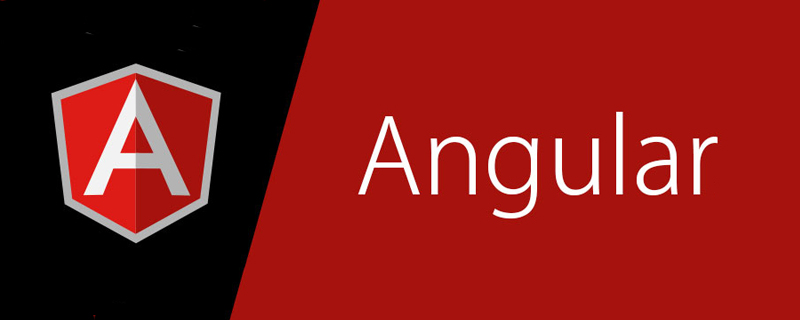本篇文章带大家聊聊angular中的响应式表单,介绍一下全局注册响应式表单模块、添加基础表单控件、把表单控件分组的方法,希望对大家有所帮助!

Angular 提供了两种不同的方法来通过表单处理用户输入:响应式表单和模板驱动表单。【相关教程推荐:《angular教程》】
这里只介绍响应式表单,模板驱动表单请参考官网—https://angular.cn/guide/forms-overview#setup-in-template-driven-forms
要使用响应式表单控件,就要从 @angular/forms 包中导入 ReactiveFormsModule,并把它添加到你的 NgModule 的imports数组中。如下:app.module.ts
/***** app.module.ts *****/
import { ReactiveFormsModule } from '@angular/forms';
@NgModule({
imports: [
// other imports ...
ReactiveFormsModule
],
})
export class AppModule { }使用表单控件有三个步骤。
在你的应用中注册响应式表单模块。该模块声明了一些你要用在响应式表单中的指令。
生成一个新的 FormControl 实例,并把它保存在组件中。
在模板中注册这个 FormControl。
要注册一个表单控件,就要导入FormControl类并创建一个 FormControl的新实例,将其保存为类的属性。如下:test.component.ts
/***** test.component.ts *****/
import { Component } from '@angular/core';
import { FormControl } from '@angular/forms';
@Component({
selector: 'app-name-editor',
templateUrl: './name-editor.component.html',
styleUrls: ['./name-editor.component.css']
})
export class TestComponent {
// 可以在 FormControl 的构造函数设置初始值,这个例子中它是空字符串
name = new FormControl('');
}然后在模板中注册该控件,如下:test.component.html
<!-- test.component.html -->
<label>
Name: <input type="text" [formControl]="name">
</label>
<!-- input 中输入的值变化的话,这里显示的值也会跟着变化 -->
<p>name: {{ name.value }}</p>
FormControl的其它属性和方法,参阅 API 参考手册:https://angular.cn/api/forms/FormControl#formcontrol
就像FormControl 的实例能让你控制单个输入框所对应的控件一样,FormGroup 的实例也能跟踪一组 FormControl 实例(比如一个表单)的表单状态。当创建 FormGroup 时,其中的每个控件都会根据其名字进行跟踪。
看下例演示:test.component.ts、test.component.html
import { Component } from '@angular/core';
import { FormControl, FormGroup, Validators } from '@angular/forms'
@Component({
selector: 'app-test',
templateUrl: './test.component.html',
styleUrls: ['./test.component.css']
})
export class TestComponent implements OnInit {
constructor() {}
profileForm = new FormGroup({
firstName: new FormControl('', [Validators.required,Validators.pattern('[a-zA-Z0-9]*')]),
lastName: new FormControl('', Validators.required),
});
onSubmit() {
// 查看控件组各字段的值
console.log(this.profileForm.value)
}
}<!-- profileForm 这个 FormGroup 通过 FormGroup 指令绑定到了 form 元素,在该模型和表单中的输入框之间创建了一个通讯层 -->
<!-- FormGroup 指令还会监听 form 元素发出的 submit 事件,并发出一个 ngSubmit 事件,让你可以绑定一个回调函数。 -->
<form [formGroup]="profileForm" (ngSubmit)="onSubmit()">
<label>
<!-- 由 FormControlName 指令把每个输入框和 FormGroup 中定义的表单控件 FormControl 绑定起来。这些表单控件会和相应的元素通讯 -->
First Name: <input type="text" formControlName="firstName">
</label>
<label>
Last Name: <input type="text" formControlName="lastName">
</label>
<button type="submit" [disabled]="!profileForm.valid">Submit</button>
</form>
<p>{{ profileForm.value }}</p>
<!-- 控件组的状态: INVALID 或 VALID -->
<p>{{ profileForm.status }}</p>
<!-- 控件组输入的值是否为有效值: true 或 false-->
<p>{{ profileForm.valid }}</p>
<!-- 是否禁用: true 或 false-->
<p>{{ profileForm.disabled }}</p>
FormGroup的其它属性和方法,参阅 API 参考手册:https://angular.cn/api/forms/FormGroup#formgroup
在响应式表单中,当需要与多个表单打交道时,手动创建多个表单控件实例会非常繁琐。FormBuilder服务提供了一些便捷方法来生成表单控件。FormBuilder在幕后也使用同样的方式来创建和返回这些实例,只是用起来更简单。
FormBuilder 是一个可注入的服务提供者,它是由 ReactiveFormModule 提供的。只要把它添加到组件的构造函数中就可以注入这个依赖。
FormBuilder服务有三个方法:control()、group()和array()。这些方法都是工厂方法,用于在组件类中分别生成FormControl、FormGroup和FormArray。
看下例演示:test.component.ts
import { Component } from '@angular/core';
// 1、导入 FormBuilder
import { FormBuilder, Validators } from '@angular/forms';
@Component({
selector: 'app-test',
templateUrl: './test.component.html',
styleUrls: ['./test.component.css']
})
export class TestComponent {
// 2、注入 FormBuilder 服务
constructor(private fb: FormBuilder) { }
ngOnInit() { }
profileForm = this.fb.group({
firstName: ['', [Validators.required, Validators.pattern('[a-zA-Z0-9]*')]],
lastName: ['', Validators.required],
});
// 相当于
// profileForm = new FormGroup({
// firstName: new FormControl('', [Validators.required,Validators.pattern('[a-zA-Z0-9]*')]),
// lastName: new FormControl('', Validators.required),
// });
onSubmit() {
console.log(this.profileForm.value)
console.log(this.profileForm)
}
}对比可以发现,使用FormBuilder服务可以更方便地生成FormControl、FormGroup 和 FormArray,而不必每次都手动new一个新的实例出来。
Validators类验证器的完整API列表,参考API手册:https://angular.cn/api/forms/Validators
验证器(Validators)函数可以是同步函数,也可以是异步函数。
FormControl 时把它作为构造函数的第二个参数传进去。Promise 或 Observable,它稍后会发出一组验证错误或 null。在实例化 FormControl 时,可以把它们作为第三个参数传入。出于性能方面的考虑,只有在所有同步验证器都通过之后,Angular 才会运行异步验证器。当每一个异步验证器都执行完之后,才会设置这些验证错误。
https://angular.cn/api/forms/Validators
class Validators {
static min(min: number): ValidatorFn // 允许输入的最小数值
static max(max: number): ValidatorFn // 最大数值
static required(control: AbstractControl): ValidationErrors | null // 是否必填
static requiredTrue(control: AbstractControl): ValidationErrors | null
static email(control: AbstractControl): ValidationErrors | null // 是否为邮箱格式
static minLength(minLength: number): ValidatorFn // 最小长度
static maxLength(maxLength: number): ValidatorFn // 最大长度
static pattern(pattern: string | RegExp): ValidatorFn // 正则匹配
static nullValidator(control: AbstractControl): ValidationErrors | null // 什么也不做
static compose(validators: ValidatorFn[]): ValidatorFn | null
static composeAsync(validators: AsyncValidatorFn[]): AsyncValidatorFn | null
}要使用内置验证器,可以在实例化FormControl控件的时候添加
import { Validators } from '@angular/forms';
...
ngOnInit(): void {
this.heroForm = new FormGroup({
// 实例化 FormControl 控件
name: new FormControl(this.hero.name, [
Validators.required, // 验证,必填
Validators.minLength(4), // 长度不小于4
forbiddenNameValidator(/bob/i) // 自定义验证器
]),
alterEgo: new FormControl(this.hero.alterEgo),
power: new FormControl(this.hero.power, Validators.required)
});
}
get name() { return this.heroForm.get('name'); }
get power() { return this.heroForm.get('power'); }自定义验证器的内容请参考 API手册:
https://angular.cn/guide/form-validation
有时候内置的验证器并不能很好的满足需求,比如,我们需要对一个表单进行验证,要求输入的值只能为某一个数组中的值,而这个数组中的值是随程序运行实时改变的,这个时候内置的验证器就无法满足这个需求,需要创建自定义验证器。
在响应式表单中添加自定义验证器。在上面内置验证器一节中有一个forbiddenNameValidator函数如下:
import { Validators } from '@angular/forms';
...
ngOnInit(): void {
this.heroForm = new FormGroup({
name: new FormControl(this.hero.name, [
Validators.required,
Validators.minLength(4),
// 1、添加自定义验证器
forbiddenNameValidator(/bob/i)
])
});
}
// 2、实现自定义验证器,功能为禁止输入带有 bob 字符串的值
export function forbiddenNameValidator(nameRe: RegExp): ValidatorFn {
return (control: AbstractControl): ValidationErrors | null => {
const forbidden = nameRe.test(control.value);
// 3、在值有效时返回 null,或无效时返回验证错误对象
return forbidden ? {forbiddenName: {value: control.value}} : null;
};
}验证器在值有效时返回
null,或无效时返回验证错误对象。 验证错误对象通常有一个名为验证秘钥(forbiddenName)的属性。其值为一个任意词典,你可以用来插入错误信息({name})。
在模板驱动表单中添加自定义验证器。要为模板添加一个指令,该指令包含了 validator 函数。同时,该指令需要把自己注册成为NG_VALIDATORS的提供者。如下所示:
// 1、导入相关类
import { NG_VALIDATORS, Validator, AbstractControl, ValidationErrors } from '@angular/forms';
import { Input } from '@angular/core'
@Directive({
selector: '[appForbiddenName]',
// 2、注册成为 NG_VALIDATORS 令牌的提供者
providers: [{provide: NG_VALIDATORS, useExisting: ForbiddenValidatorDirective, multi: true}]
})
export class ForbiddenValidatorDirective implements Validator {
@Input('appForbiddenName') forbiddenName = '';
// 3、实现 validator 接口,即实现 validate 函数
validate(control: AbstractControl): ValidationErrors | null {
// 在值有效时返回 null,或无效时返回验证错误对象
return this.forbiddenName ? forbiddenNameValidator(new RegExp(this.forbiddenName, 'i'))(control)
: null;
}
}
// 4、自定义验证函数
export function forbiddenNameValidator(nameRe: RegExp): ValidatorFn {
return (control: AbstractControl): ValidationErrors | null => {
const forbidden = nameRe.test(control.value);
// 3、在值有效时返回 null,或无效时返回验证错误对象
return forbidden ? {forbiddenName: {value: control.value}} : null;
};
}注意,自定义验证指令是用
useExisting而不是useClass来实例化的。如果用useClass来代替useExisting,就会注册一个新的类实例,而它是没有forbiddenName的。
<input type="text" required appForbiddenName="bob" [(ngModel)]="hero.name">
更多编程相关知识,请访问:编程视频!!
以上就是一文聊聊angular中的响应式表单的详细内容,更多请关注php中文网其它相关文章!

每个人都需要一台速度更快、更稳定的 PC。随着时间的推移,垃圾文件、旧注册表数据和不必要的后台进程会占用资源并降低性能。幸运的是,许多工具可以让 Windows 保持平稳运行。




Copyright 2014-2025 https://www.php.cn/ All Rights Reserved | php.cn | 湘ICP备2023035733号